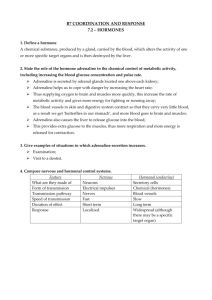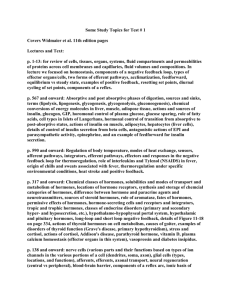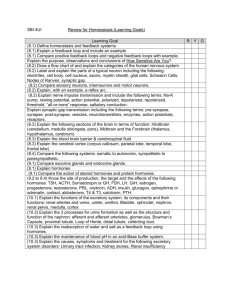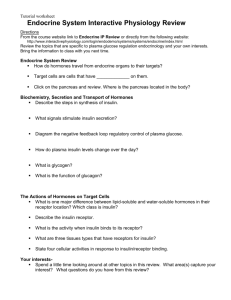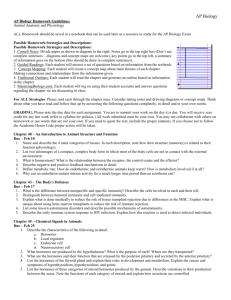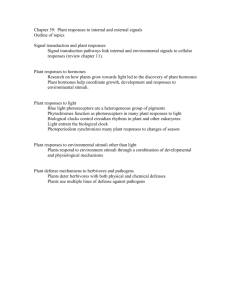Lecture_19.General_characteristic_of_hormones_as_medicine
advertisement
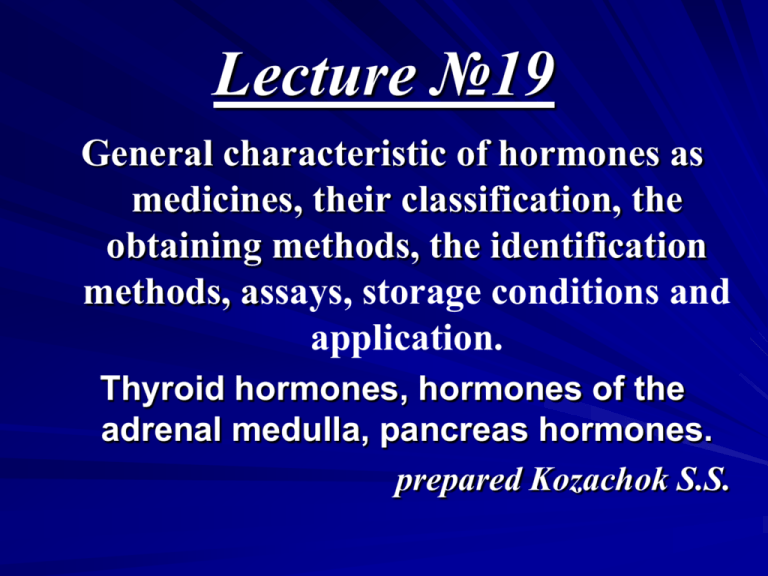
Lecture №19 General characteristic of hormones as medicines, their classification, the obtaining methods, the identification methods, assays, storage conditions and application. Thyroid hormones, hormones of the adrenal medulla, pancreas hormones. prepared Kozachok S.S. Hormones are biologically active substances that are produced by glands of internal secretion in very small quantities, and regulate all the vital processes occurring in the body. Only sex hormones affect more than 120 body functions. The formation process of hormones is regulated by the hypothalamus it is a brain region which is under the optic tubercles. Nowadays there are about 50 natural hormones. As drugs there are used galena preparations and individual hormones, which are derived from endocrine glands of a beef cattle as well as synthetic analogs of natural hormones. Hormones have long been classified according to their place of origin, taking into account their physiological effect: thyroid hormones, pancreatic hormones, adrenal hormones, etc. Recent advances in the chemistry of hormones Over the past decade in the chemistry of hormones there have been many new studies. It was synthesized the hypophysis hormones, several hypothalamic hormones. Some of them (rifatiroin, somatostatin) are recommended for clinical use. Discover morphinesimilar hormones (enkephalins, endorphins), hormones of memory and sleep. This is one of the ways to create new analgesics that are not addictive. Create the new methods of synthesis of neurohormones with peptide structure, and many of their structural analogs. It turned out that some of them may affect on the heart, showing mediator or modulator of the function, which allows using them for atherosclerosis and myocardial infarction. Established the chemical structure and the synthesis of insulin. However, the chemical synthesis of this hormone has only theoretical interest, since the yield of the final product is very small and the cost of performing the synthesis of significant. Therefore, insulin is extracted based on animal products or by genetic engineering. Tissue hormones or kinins have the importance role for the body's vital functions. They are formed not in the endocrine glands, but at various points in the body, where their influence is currently required. Kinins have a peptide structure. They regulate the basic biochemical and physiological processes in the body and affect on many of its functions. This gave impetus to the use of some of kinins in human and veterinary medicine. Modern studies of drugs of animal origin are carried out in several directions. The components of organs and tissues cause the greatest interest in studying, which in chemical structure are proteins, glycosaminoglycans and nucleic acids. They have a wide range of actions. Obtained drugs from the thymus gland, prostate, trachea, blood vessels and other organs of the animal materials. Chemical classification of hormones 1. a) b) c) d) e) 2. a) b) c) d) Hormones that have the structure of amino-acid, amino alcohols, polypeptides, proteins and their derivatives : thyroid hormones and their synthetic analogues; parathyroid hormone; pituitary hormones; Hormones of the pancreas; Hormones of adrenal medulla . Hormones that have the steroid structure : Cortical layer of the adrenal hormones (corticosteroids) and their semisynthetic analogs; progestin (lutoidin) hormones and their semisynthetic analogs; androgenic hormones and semisynthetic anabolic drugs; estrogenic hormones and their synthetic analogs of nonsteroidal structure. Thyroid hormones Thyronine derivatives of the thyroid gland have biological activity: In 1914, Mr. Kendall is siparated out from the thyroid gland of a cattle thyronine tetraiodidne derivative (chemical structure was established in 1927). This substance called thyroxine (3,5,3',5'-tetraiodothyronine): The presence of an asymmetric carbon atom determines the presence of two optical isomers, of which L-thyroxine which is 3 times more active than D-isomer. In the 1952-1955 years , it was proved that the hormonal activity of the thyroid gland the thyroxine does not only have, but other iodo derivatives of the thyronine: 3,5,3'-triiodothyronine and 3,3'diiodothironine Biosynthesis of these hormones in the body is produced by the tyrosine and iodine, which enter to the body with food and water. In medical practice, there is using thyroidin, synthetic Lthyroxine and triiodothyronine as sodium salts. Thyroidin Thyreoidin contains hormones of L- thyroxin and L-3,5,3’triiodo thyronine. Obtaining by the drying and grinding the thyroid glands of a cattle. Yellowish-white powder with faint odor that is a characteristic of the dried animal tissues. Not soluble in water and other solvents, soluble in alkalis and carbonates (acid properties). Store in a well-sealed jars of dark glass. Apply at the hypofunction of thyroid gland, which leads to the hypothyroidism, myxedema, cretinism, obesity or endemic goiter. H.s.d.-0, 3 g; H.d.d.-1, 0 g. Identification of Thyroidin 1. Protein is determined by the formation of yellow color after boiling the drug in alkaline solution. With further addition of diluted sulfuric acid solution there is decolorizing and droping out the white colloidal precipitate. 2. To determine the organically bound of iodine the preparation is destroyed by the calcination with a mixture of KNO3 and Na2CO3. Forming iodides are extracted with water and identified by the oxidation of chloramines in the HCl environment. Iodine liberated, the chloroform layer is coloured in redviolet color. 3. 4. Thyroidin is burned with oxygen in the flask. As an absorption substance using a starch solution that contains 0.2% sulfamic acid. Iodine forms during combustion, it paints an absorbing layer in blue. Gives reaction of the phenolic hydroxyl with FeCl3. Quantitative determination In thyroidin there is determined the content of the organically iodine bound. Spending the mineralization by perhydrol in the presence of concentrated H2SO4 (USPh X).Forming the iodides and partial oxidation of iodides to iodates. Iodides is oxidized to iodates by the solution of KMnO4: The excess of KMnO4 is removed by NaNO2 solution: Possible excess of the nitrates can be destroyed by an urea: In the solution, there is only one oxidant - iodate acid in an amount equivalents to the iodine content in thyroidin precise mass. To add a solution of KI and iodine, that was separated, it titrated by Na2S2O3 solution : Thyroidin contains 0,17-0,23 % of the iodine. Ем=1/6Ам(І). 2. Mineralization is carried out in a flask combustion with oxygen (SP XI): RСН2І + О2 → І2 + СО2 + Н2О Evolving iodine is absorbed by NаОН: І2 + 2NаОН → NaІO + NaІ + Н2О For the oxidation of the forming iodides in the flask to put acetate bromide solution till yellow colour: 2Br+(СH3СOO)- + NaІ + Н2О → Br2 + NaІO + 2CH3СОOH NaІO + NaІ + 5Br2 + 5Н2О → 2NaІO3 + 10HBr Then to add the concentrated formic acid solution till the colourlessing of the solution: НСООН + Br2 → 2НBr + СО2 Bromine residual traces is pumped. At the thyroidin combustion also forming nitrogen oxides, which dissolves in a solution of NaOH, converting to nitrite ions. For the delation of them to add to the reaction mixture 3% solution of sulfamic acid : H2N-SO2OH + HNO2 → H2SO4 + N2 + Н2О Therefore, remove all oxidants except iodate equivalent to the content of iodine bound in the sample. After that, in the flask to add 1 g of KI, which interacts with iodate, allocates an equivalent amount of iodine. It is titrated by 0.005 M Na2S2O3 (indicator - starch): 2NaІO3 + 10КІ + 6H2SO4 → 6І2 + Na2SО4 + 5K2SO4 + 6Н2О I2 + 2 Na2S2O3 → NaІ + Na2S4O6 Parallel to do a control experiment (without burning). Ем=1/6Ам(І). Levothyroxine sodium (SPU) Levothyroxinum natricum I I NH2 HO O CH2 CH O H2O C ONa I I Sodium (2S)-2-amino-3-[4-(4-hydroxy-3,5diiodidophenoxy)-3,5- diiodophenyl] propanoate hydrate The synthetic levogyrate isomer of thyroxine (L-thyroxine). Properties. Fine crystalline powder, almost white or slightly brownish-yellow color. Very slightly soluble in the water, slightly soluble in 96% ethanol, practically insoluble in the ether. Soluble in dilute alkali. Liothyronine Sodium (SPU) Liothyroninum natriсum I I NH2 HO O CH2 CH O C ONa I Sodium (2S)-2-amino-3-[4-(4-hydroxy-3-iodophenoxy)-3,5diiodophenyl] propanoate Synthetic analogue of triiodothyronine to 5 times stronger than L-thyroxine. Properties. The white or slightly colored powder. Very slightly soluble in the water, slightly soluble in 96% ethanol. Soluble in dilute alkali. Identification of sodium salts Levothyroxine Liothyronine 1. Specific optical rotation 1. Specific optical rotation 2. IR spectroscopy 2. IR spectroscopy 3. TLC 3. UV - spectroscopy 4. To the substance to add some drops of the concentrated H2SO4 and heat – forming the steam of the violet color (iodine). 5. After mineralization (under the action of the diluted H2SO4 ) it gives reaction of sodium. Assay 1. Both drugs were determined by liquid chromatography. 2. Combustion in a flask with oxygen, using for the absorption NaOH. Than Iodometry (see thyroidin). 3. The method is based on the dehalogen at the heating with zinc powder in alkaline medium: I HO I O C H2 H C COOH + 2 Zn + 9 KOH NH2 I HO I O C H2 H C COOK + 4 KI + 2 K2[Zn(OH)4] + H2O NH2 Then to do argentometric titration educated iodide ions (indicator sodium eosinate). Еm=1/4М.m. 4КІ + 4AgNO3 → 4AgI + 4KNO3 Storager – in the airtight containers. In the dark place, at 2-8 0С. Remedy of the synthetic analogs of thyreodine: L - thyroxine (levothyroxine) (Pharmak) 50 mg and 100 mg № 50. Triiodothyronine (Borschagovsky Chemical Plant ) - liotironine Novotiral (levothyroxine + liotironine) Tiratrikol (Triakan) - 3,5,3 '- triiodotiacetate acid a physiological metabolite of liotironine. Iodtirox - levothyroxine + potassium chloride Antithyroid drugs (for treatment of toxic goiter) merkazolil (tiamazol) Metizol. Hormones of adrenal medulla (catecholamines and their synthetic analogues) Adrenal glands - paired glands, which are composed of two layers: cortical and medullary (inner). Medulla layer produces the hormone of adrenaline and noradrenaline accompanying to it, and the cortical layer - about 40 different hormones, which are called corticosteroids. Adrenaline was first identified by a russian scientist Cybulski M.O. at the end of the XIX century, and in 1903 established its structure, which is confirmed by synthesis. Raw material for production of adrenaline and corticosteroids is a adrenal (gland) of a beef cattle. So from 45 kg of the adrenal glands receive only 9.5 grams of pure adrenaline. Therefore, in the present preparations of adrenal hormones are obtained only synthetically ways. Despite there are several hydrophilic groups in the molecule, the adrenaline practically insolubles in water according to the formation of betaine (inner salt, zwitter-ion). From aqueous solutions of salts (hydrochloride, hydrotartrate) it can be settled down the base of adrenaline with ammonia, filtered, dried and used for the determining of the specific rotation. In medical practice, there are using of adrenaline (epinephrine) hydrochloride, epinephrine tartrate, noradrenaline hydrotartrate and their synthetic analogs mezaton (phenylephrine h/ch) izadrin (isoprenaline h/ch) berotek (fenoterol h/br), salbutamol, verapamil h/ch. Properties. Adrenaline and noradrenaline hydrotartratis white or white with a yellowish white crystalline substance, odorless. It easily solubles in water, practically insoluble in ether and chloroform, practically insoluble in ethanol. Like other phenols, these compounds are soluble in alkaline solutions, can be oxidized. Under the influence of light and oxygen they form a colored oxidation products. They have amphoteric properties. As diatom phenol it is easily oxidized and is a good reducing agent. Natural adrenaline levogyrate, synthetic racemate. Adrenaline tartrate (Adrenalinі tartras)(SPhU 1.1) Epinephrine bitartrate* HO OH HO HO C H C H2 N H CH3 * HOOC H C C H COOH OH (1R)-1 -(3,4-dihydroxyphenyl)-2-(methylamino) ethanol hydrogen (2R,ЗR)-2,3-dihydroxy butandioate Noradrenaline hydrotartrate(Noradrenalini hydrotartras) Levarterenol bitartrate* HO OH HO HO C H C H2 NH2 * HOOC H C C H COOH * H2O OH (-)-1-(3,4-Dioxyphenyl)-2-amino ethanol hydrotartrate Synthesis scheme of remedies of adrenaline and noradrenaline The gotten racemate according the synthesis are separated by the tartratic acid, using different solubility of the hydrotartrates in alcohol. Levogyrate tartrate isomer is not soluble in alcohol, dexter levogyrate - soluble. Identification 1. The specific rotation after transfering to the chloride salt, ultraviolet and infrared spectroscopy. To the aqueous solution of a substance to add diethoxy tetrahydrofuran in the concentrated acetate acid and heated. To a cooled solution to add dimethyl amino benzaldehyde solution in a mixture of hydrochloric and acetate acids. The obtaining and the control solution have the same yellow color. Reaction on tartrate: a substance is heated with potassium bromide and resorcin in the presence of concentrated sulfuric acid, appearance a dark blue color. After cooling to add water, color changes to red: 2. 3. HO H C O COOH + HOOC C H C 2 H2SO4 OH H OH COOH + COOH H2SO3 + H 2O ; OH OH OH C CH OH COOH COOH + 2 C O OH [O] KBr - H2O H . HO OH HO O 4. Oxidized by 0,1М iodine solution in the buffer solutions with рН 3,56 and 6,5. Adrenaline an this condition forms adrenochrome, which gives dark-red color of solution (рН 3,56) (SPU) or red-violet (рН 6,5) color. Noradrenaline forms noradrenochrome (red-violet color) only in the solution with рН 6,5. 5. a) b) c) d) e) Not pharmacopeial reaction: Due to the presence of two phenolic hydroxyl epinephrine and norepinephrine with a solution of FeCl3 form an emeraldgreen color, which transfers by the adding drops of ammonia solution to a cherry-red, then an orange-red colors. On the tartrate ion reaction with a potassium salt. With Tollens reagent (silver is reduced from the amino solution). With Felling reagent (orange-red sediment Cu2O). Color reaction with 1,2-dinitrobenzene - blue-violet color. HO CH NH CH3 O OH OH HO O CH NH CH3 + H2 OH O OH KO NH NO2 NO2 H2 NO2 KOH N OK N+ O- f) In alkaline solution of adrenaline is oxidized by atmospheric oxygen to form adreno lutain - there is a yellow-green fluorescence. g) At the heating with NaOH or KOH adrenaline and noradrenalin have hydroamino splitting to form 3,4-dioxyacetophen and methylamine or ammonia: Purity tests By the UV- spectrometry it is determined in adrenaline tartrate adrenalon in norepinephrine hydrotartratis noradrenalon; Noradrenaline in adrenaline tartrate is determined by TLC. Assay of adrenaline and noradrenaline hydrotatrates (SPhU) 1. Acidimetry in nonaqueous medium. Titrate in the present of the concentrated acetic acid, the indicator - crystal violet (Е=М.m). 2. 3. 4. The content of drugs in solutions for injections it is determined by photocolorimetry (color reaction with Iron-citrate reagent, 1,2-dinitrobenzene). UV- spectrometry. Alkalimetry. Ем = М.m./2. Storage In the dark place in airtight container. Easily oxidized when exposed to light and oxygen, and therefore stabilizing the solutions for injection of adrenaline and noradrenaline hydrotartratis by the adding of the reductant - 0,1% sodium metabisulfite (disulfite) Na2S2O5. Application Adrenaline and noradrenaline hydrotartratis used as adrenomimetic (vasoconstrictor) remedy. They are prescribed an the collapse, a sharp decrease in blood pressure as a result of injuries, poisonings, during surgery to reduce bleeding and blood loss. Adrenaline hydrotartrate is injected hypodermic as 0.18% solution of 0,1-0,5 ml, norepinephrine hydrotartratis intravenous 0.2% solution. In oculus medical practice (dilates the pupil) using 0,1% solution of adrenaline. Phenylephrine hydrochloride (Phenylephrini hydrocloridum) (SPhU) Mesaton (Mesatonum) HO OH C H C H2 N H CH3 * HCl (1R)-1-(3-Hydroxyphenyl)-2-((methylamino) ethanol hydrochloride Synthetic analogue of the adrenaline. CHARACTERS. Appearance. White or almost white, crystalline powder. Solubility. Slightly soluble in water, sparingly soluble in methanol, slightly soluble in ethanol (96 per cent). It dissolves in dilute mineral acids and in dilute solutions of alkali hydroxides. Identification of Phenylephrine hydrochloride 1. 2. 3. 4. Specific optical rotation, melting point, ІR-spectroscopy. Gives reaction of chloride. With CuSO4 at present of NaOH mezaton forms the complex of a violet color, which , unlike ephedrine, insoluble in ether. Not pharmacopeial reaction: with FeCl3 (on the phenol hydroxyl) – violet color. ASSAY 1. 2. (SPhU). Alkalimetry. Substance is dissolved in a mixture of 0.1 M HCl and 96% ethanol and titrated by 0.1 M ethanolic solution of NaOH potentiometrically. At the calculation to taken the volume of titrant between the two potential jumps on the titration curve. Em = M.m. Return bromatometry. Indicator – starch. Parallel to do control test. Ем = 1/6 М.m. Acidimetry in nonaqueous medium, a direct titration at the present of mercury (II) acetate. Еm = М.m. 3. Alkalimetry. Еm = М.m. 4. Argentometry. Еm = М.m. 5. Mercurimetry. Еm = М.m. 2. Application Alpha-adrenoceptor agonist, Adrenomimetic (vasoconstrictor) agent. Release. Solution for injection 1% 1,0 № 10: mezaton-, Mesafeton-Darnisa. Nazol-baby - a drop of 0,125% 15 ml. Combination preparations: Farmacitron (10 mg), Coldrex (10mg), KOLDFLU, rinza, TeraFlu, AntiFlu, Anticataral. Isadrine (Isadrinum) hydrochloride* H C HO CH3 C H2 N H CH * HCl CH3 OH HO 1-(3,4-dioxyphenyl)-2-isopropilaminoethanol h/ch Synthetic analogue of adrenalіne . Properties. White crystalline powder, freely solubles in water. Melting point 167-169 °C. Under the action of atmospheric oxygen and light, easily oxidized and becomes pink. Adrenomimetic tool. Unlike adrenaline, greatly expands the bronchial tubes, slightly vasoconstrictor. Using at bronchial asthma. Administered by inhalation of 1 ml of 0.5% solution. Identification of isadrine IR- and UV-spectroscopy. Chloride’s reaction. With FeCl3 – green color, at the adding NaHCO3 transfers to a dark blue, аnd than to a red. 4. The formation of the isopropyladrenochrome. The drug is dissolved in the two buffer solutions, whith pH 3.5 and 6, 5. When mixing these solutions with 0.05 M iodine solution and bleaching of the iodine excess after 5 minutes. the first solution becomes intensely red and the second one - a redviolet (unlike noradrenaline). 5. With Tollens and Felling reagents. 6. With HNO2 – dirty-violet color. 7. Azoconection reaction (on phenolyc radical) - cherry-red coloration. 8. With a basic CuSO4 solution – the complex has dark green color. 1. 2. 3. ASSAY Kjeldahl method. Еm = М.m. Acidimetry in nonaqueous medium. Еm = М.m. Hormones of the pancreas. Insulin. Insulin is a hormone that is produced by Langerhans islets of the pancreas (from Lat. insula - island). It has the huge influense on the carbonate exchanging reaction in our body. Using inside insulin the level of suger in blood extremely reduces. Insulin is used for the treatment of diabetes. Insulin is obtained by the extraction from the pancreas of beef cattle, or by genetic engineering. This crystalline powder, readily soluble in water. Ebel was first extracted insulin in 1925. Pharmaceutical agent is insulin injection (Insulinum pro injectionibus), which is prepared by dissolving the crystalline powder of insulin in water, acidified with HCl. For the preservation of insulin was added to a solution of 0.3% solution trikrezola. Remedy is an insulin for injection (Insulinum pro injectionibus), which is prepared by dissolving the crystalline powder of insulin in water, acidified with HCl. For the preservation of insulin there was added to a solution of 0.3% tricresol solution. The drug is a clear, colorless or slightly yellowish liquid acid reaction (pH 2,5-3,5), with the smell of preservative. According to the chemical structure insulin is a macromolecular compounds of protein nature. The empirical formula of its is С254H337N65S6. Molecular weight - 5733.5. In 1945-1956 Sanger for the first time established the chemical structure of insulin. At the oxidation of the formic acid HCOOOH it is divided into two monomeric peptides - A peptide composed of 21 aminoacids, peptide B - with 30 aminoacids. Placement of the aminoacids in the insulin molecule doesn’t have the order. This protein has an unique structure. Animals insulin has the same structure of the peptide B, but slightly different structure of peptide A. Since pig’s insulin has in 8-th position threonine (instead of alanine), and in position 10-th isoleucine (instead of valine). For identification to the remedy to add by drops the diluted NaOH solution – forming the flakes sediment, which dissolves at the acidifying. Insulin is easily destroyed by digestive enzymes, so it does not take per os. It is injected hypodermic, inner muscular. 1 МО = 0,045 mg of the crystalline insulin. Insulin syringes 100 AU/ml and 40 AU/ml. Released in sterile vials on 5 and 10 ml, sealed with rubber caps. 10 ml of liquid = 20 or 40 MO. The drug remains active for 1.5 years when stored in a cool place. Insulin is a short action (Farmasulin H humanity, Himulin regular humanity, Humudar R humanity, pork) and the midle actopn (Farmasulin HL humanity, Himulin NPH, Humodar B, B-insulin, pig.). Thank you for attention
